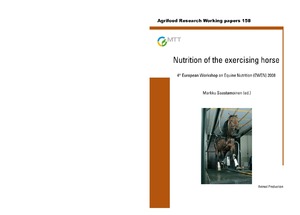Heat balance in trotters during intense exercise
Morgan, Karin; Nyman, G; Funkquist, P (2008)
Morgan, Karin
Nyman, G
Funkquist, P
Julkaisusarja
Agrifood Research Working papersMTT:n selvityksiä
Numero
158
Sivut
s. 23
MTT
2008
Tiivistelmä
The aim of this pilot study was to investigate heat balance; especially heat loss and heat load. Four standardbred trotters (geldings, 3-8 years, 420-520 kg) performed twice an inclined (1.4 ) incremental treadmill exercise test in two minutes steps (7, 8, 9, 10 and 11 m/s) in indoor conditions (15 C, 40% Relative humidity). The recovery was monitored for 120 minutes. We measured throughout the entire experiment: heart rate, respiratory rate and temperatures in central venous blood, the gluteus medius muscle and radiated from skin. Oxygen uptake and sweat rate were measured during exercise and 30 minutes after exercise. The rate of non-evaporative heat loss was estimated from measured parameters. The data were analysed for correlations. The results showed that as the intensity of work increase, the pathways of dissipated heat shifted; skin non-evaporative (75% š20%), sweat (4% š55%), and respiratory (21% š25%) heat loss. We found the following correlations between 1) central venous temperature and muscle temperature (R2= 0.81), 2) central venous temperature and oxygen uptake (R2= 0.85), 3) intensity of work (%VO2 max) and momentary heat load in W.m-2 (R2= 0.97), 4) accumulated heat load and muscle temperature (individual R2= 0.94-0.99, overall R2= 0.71) during exercise, where specific heat of the horse was estimated to 2500 J.kg-1 . C-1. During recovery there was no obvious correlation between accumulated heat load and muscle temperature, which indicated a shift of heat within the body. The results obtained provide useful data for modelling heat balance and thermoregulation within the horse during exercise, especially the preliminary estimation of specific heat.
Collections
- Julkaisut [85588]
